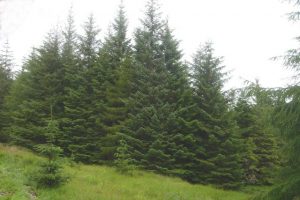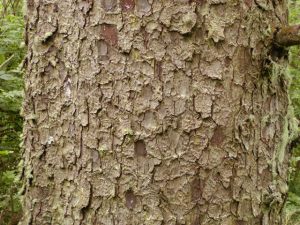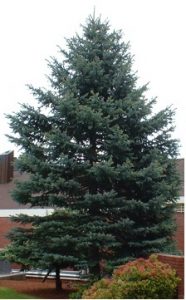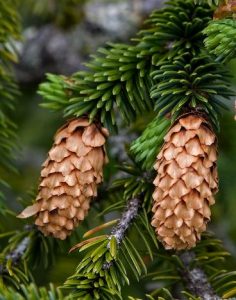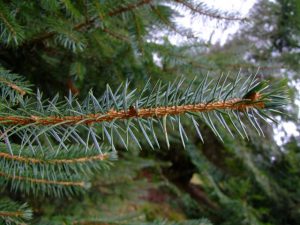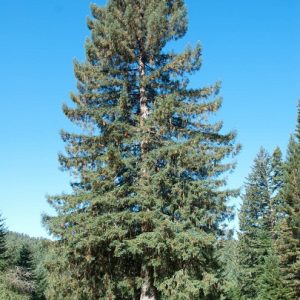Sitka Spruce
What is Sitka spruce?
Named after the Sitka community in Alaska, the Sitka spruce is a species of large evergreen conifers found in the western coastal regions of North America at an elevation of 400-1000 m. Being the third tallest coniferous tree species in the world, the Sitka spruce is known to reach over 90 meters in height.
Scientific Classification
| Kingdom | Plantae |
| Division | Pinophyta |
| Class | Pinopsida |
| Order | Pinales |
| Family | Pinaceae |
| Genus | Picea |
| Scientific Name | Picea sitchensis |
Quick Information
| Other Names | Menzies’ spruce, Yellow spruce, Tideland spruce, Western spruce, Silver spruce, Coast spruce |
| Size | Commonly 70-80 m tall; straight trunk with a diameter of 500 cm dbh |
| Identification | Leaves: Stiff, needle-like; 15-25 mm long, cross-section is flattened; blue-green above with 2-3 thin lines, bluish-white below with two bands of stomata Cones: Slim, cylindrical, pendulous, 6-10 cm in length, 2-3 cm in width; green or reddish when young, light brown when matured; thin, flexible scales and black seeds Bark: Thin, scaly, comes off in circular plates measuring 5-20 cm across |
| Crown/Top | Broad, conic when young, become cylindrical at maturity |
| Distribution/Range | British Columbia (Canada); Alaska, Oregon, California, Washington (USA) |
| Hardiness Zones | 7-8 |
| Growth Rate | Grows rapidly, 1.5 m per year |
| Lifespan | Long-lived tree; can live for more than 700 years |
| Growing Conditions | Winter Conditions: Thrives in areas with mild winters Summer Conditions: Places where summers are cool Rain: Needs moist conditions; annual precipitation varies between 635 mm and 5615 mm within its range Sunlight: Prefers exposure to full sun; tolerates partial shade Soil Requirements: Deep, moist, sandy, acidic, well-aerated; alluvial soil rich in magnesium, calcium, and phosphorus |
| Diseases and Pests | Root rot caused by Armillaria mellea and Heterobasidion annosum; brown pocket rot, red heart rot, cottonwood rust, spruce broom rust, and some other diseases affecting foliage and stem; pest insects such as spruce beetle, white pine weevil, spruce aphid, and root-collar weevil |
| Flowering/Fruiting | Cones are produced between 20 and 40 years of age, reproductive buds develop in early summer, pollens are shed during late April-early June |
| Breeding System | Monoecious |
| Seed Production | Seeds ripen during late August-early September, dispersed in October; to release seeds, cones open when the weather is dry but reclose during wet conditions |
| Seedling Development | Seeds germinate on any seedbed, though their survival is low |
| Wildlife Value | Large ungulates browse the shoots and leaves in the spring; the blue grouse feeds on the needles in the winter; habitat for woodland caribou, mountain goat, Roosevelt elk, Alaskan brown bear, and Sitka deer; used by the bald eagle and the peregrine falcon for nesting and roosting |
| Hybrids and Cultivars |
|
| Uses | Timber, paper production, the lumber is used for making sounding boards for pianos, violins, and guitar faces; the wood is valuable in constructing components of light aircraft, sailboat spars, masts, and oars, as well as arrow shafts |
| IUCN Conservation Status | Least Concern |
Comparison with Engelmann and Adirondack Spruce
Adirondack spruce vs. Sitka spruce: Adirondack spruce has four-sided, curved, and yellowish-green needles while Sitka spruce has flattened, bluish-green needles; the cones in Sitka spruce are much larger than those in Adirondack spruce.
Engelmann spruce vs. Sitka spruce: The Sitka spruce trees are larger and taller than Engelmann spruce, and their native range does not extend beyond 80 km from the Pacific coast.
Interesting Facts
- The Queets Spruce, located in Olympic National Park, is the largest Sitka spruce in the world with a trunk diameter of 14.9 ft (4.55 m) at breast height, trunk volume of 11,900 cu ft (337 m3), and a height of 248 ft (75.6 m).
- The Sitka spruce Carmanah Giant, located in Carmanah Walbran Provincial Park, is the tallest in Canada with a height of 315 ft (96 m).
- Some of the Sitka spruce trees in Olympic National Forest, Washington often develop tumor-like swellings, called burls.
- The Wright Flyer, created by the Wright brothers, was built with Sitka spruce. Before the Second World War, many warplanes were constructed using Sitka spruce wood. It was also used in building the nose cones of Trident I ballistic missiles.
- A unique Sitka spruce with golden colored needles, named the Golden Spruce or Kiidk’yaas, grew in Haida Gwaii, British Columbia. Unfortunately, the rare specimen was secretly felled in January 1997 by a forest engineer Grant Hadwin. The indigenous Haida people still consider this tree as sacred.
References:
- https://www.for.gov.bc.ca/hfd/library/documents/treebook/sitkaspruce.htm
- https://en.wikipedia.org/wiki/Picea_sitchensis
- https://www.fs.usda.gov/database/feis/plants/tree/picsit/all.html
- https://www.forestresearch.gov.uk/tools-and-resources/tree-species-database/sitka-spruce-ss/
- https://www.iucnredlist.org/species/42337/2973701



